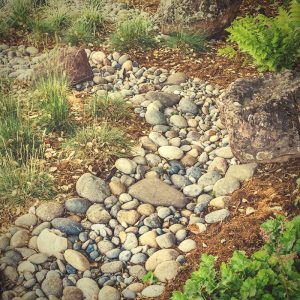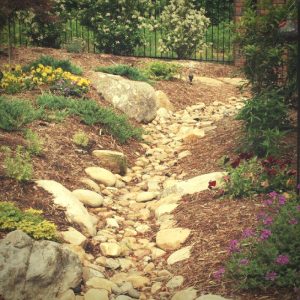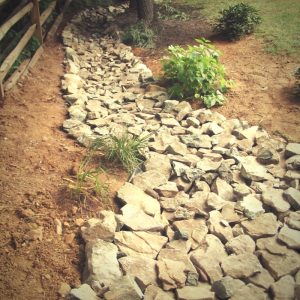A swale is wise landscaping that puts water where it belongs: underground, where the plant roots can drink it to grow healthy gardens, and the excess water can trickle down to become part of the water table. Water underground can’t erode the soil above ground. These sustainability concepts keep slopes in place and prove to be valuable resources.
Stop Runoff and Fertilize Soil With a Swale
 The swale is a long ditch dug on contour, keeping the same level its entire length so that stormwater rolling down a hill comes to a stop. With heavy mulch, water resting at the bottom is out of the wind and does not heavily evaporate into the atmosphere. A good mulch will also keep the dirt protected for the bacteria and worms to work the soil, keeping it loose for better drainage. Some swales are packed smooth on just the incoming slope, allowing water to flow to the bottom of the ditch before soaking into the layers of earth beneath.
The swale is a long ditch dug on contour, keeping the same level its entire length so that stormwater rolling down a hill comes to a stop. With heavy mulch, water resting at the bottom is out of the wind and does not heavily evaporate into the atmosphere. A good mulch will also keep the dirt protected for the bacteria and worms to work the soil, keeping it loose for better drainage. Some swales are packed smooth on just the incoming slope, allowing water to flow to the bottom of the ditch before soaking into the layers of earth beneath.
Swales are Great for Soil Slope Stabilization
Swales nearly eliminate the erosion around them. Those deep healthy roots fed by the swale will grip the slope’s dirt, weaving it together with the fine living and decaying root matter to hold it in place. Top soil near the swale will be subject to far less damage from rain runoff, staying preserved where it is, and getting richer with compost and mulch. The saved top soil provides yet more vegetation opportunities, which will further the stabilization of the slope even more. With foliage protecting the ground, wind won’t blow top soil away, and the sun cannot fry the life from the soil as easily. With swales, the slope has turned into a living sponge that is unlikely to move.
 The water table beneath the ground can be kept healthy by swales, too, continuously recharged by the deep soaking capabilities the swale has. People can draw reasonable amounts of water from the swale fed well without depleting it. Full aquifers won’t collapse, preventing the ground on steep hills from giving way. An otherwise neglected underground water system will be taken care of.
The water table beneath the ground can be kept healthy by swales, too, continuously recharged by the deep soaking capabilities the swale has. People can draw reasonable amounts of water from the swale fed well without depleting it. Full aquifers won’t collapse, preventing the ground on steep hills from giving way. An otherwise neglected underground water system will be taken care of.
Swales Make Rich Gardens
Swale plants have the benefit of a deep watering system, and are able to grow quick and healthy. Plants should eventually shade the swale itself to prevent evaporation and receive even more water at the roots. The trees and shrubs prevent harsh winds from reaching the growing vegetables as well.
The swale’s front berm needs shrubs or trees suitable to drink the amount of water that is deposited from the swale. Living on the top of this berm, the shrubs will have very good drainage. These can be native trees suited for the climate, or even fruit trees that will grow good things for people to eat. The important aspect is that they are large semi-permanent vegetation with deep stretching roots and the ability to shade the swale itself.
 The remaining swale space is available to any rotation of crops. If initial soil conditions aren’t optimal, a swale can first be planted with vegetation that builds the soil. Legumes, such as Acacia trees, clover, and beans, are useful for fixing nitrogen to fertilize the dirt. In successive plantings, trees, shrubs, vegetables, and other crops can grow located by their sun and water needs. Crops that don’t mind shade, such as lettuce, will be happy to grow at the bottom of the swale where they are protected by taller plants and the slopes of the swale itself. Carrots can grow closer to the top of the berm, between trees, where they will enjoy the drainage and absorb more sun.
The remaining swale space is available to any rotation of crops. If initial soil conditions aren’t optimal, a swale can first be planted with vegetation that builds the soil. Legumes, such as Acacia trees, clover, and beans, are useful for fixing nitrogen to fertilize the dirt. In successive plantings, trees, shrubs, vegetables, and other crops can grow located by their sun and water needs. Crops that don’t mind shade, such as lettuce, will be happy to grow at the bottom of the swale where they are protected by taller plants and the slopes of the swale itself. Carrots can grow closer to the top of the berm, between trees, where they will enjoy the drainage and absorb more sun.
Garden Landscaping of Sustainable Proportions
The environment, families, and geotechnical engineers couldn’t ask for a more reliable way to keep a steep slope in place. Beyond soil reinforcement, such a large range of benefits make this landscaping investment well worth the digging required. Aside from the food it can produce, the compost, and firewood harvested from the occasional tree, a well placed bench beneath the shade makes a great place to relax on a hot sunny day.
The post Landscape Swale Adds Beauty and Function appeared first on All around the house.
from All around the house http://allaroundthe.house/landscape-swale/
via IFTTT
Comments
Post a Comment